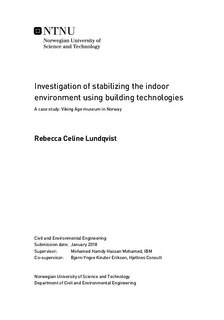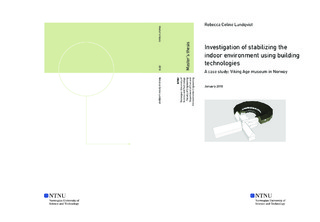| dc.description.abstract | The objective of this thesis was to investigate techniques for temperature and relative humidity stabilization for the new Viking Age museum in Oslo. The thesis is based on a project conducted at Hjellnes Consult at the same time as this is written.
Research questions that was investigated
1. What kind of building technologies can be used to stabilize the indoor environment in northern countries?
2. By how much can the temperature and relative humidity be dampened, and is there a difference in possible effects for a TEK building and a Passive house building?
One concept for temperature stabilization and one for stabilization of relative humidity was investigated. For temperature stabilization the building technology based on Phase Change Materials (PCM) was looked at, while moisture buffering in wall enclosures by different materials were looked at for relative humidity stabilization. For this work a model was made in the dynamic whole-building simulation program IDA ICE, based on a BIM-model of the museum. A model of the whole building was made, while only results of temperature and relative humidity for the exhibition zones that will host the Viking Skips were analysed.
Simulations proved that PCM can reduce the indoor air temperature fluctuations for the Passive house by maximum 1.6℃, and by 1.1℃ for the TEK-house. This occurs when the amount of PCM is equal to the area of internal walls and floor in the zone. It is more realistic to incorporate PCM in the only internal floors, which gave reduction of temperature of 1.1℃ and 0.9℃ for the Passive house, and TEK-house respectively. The temperature is dampened more in a passive house, than in a TEK-house when the same amount of PCM is incorporated.
Materials that have proved to have good moisture buffering capacity were chosen for simulations. The tested materials were cellular concrete, lime plaster, gypsum board and spruce wood board. A relative humidity stabilization (RHS) parameter was defined to quantify the stabilization effect on the fluctuation. Lime plaster and gypsum board reduced the relative RHS with less than 1% for the TEK-house, and the Passive house. Cellular concrete had no impact for the TEK-house, while it reduced the RHS with up to 3.3% for the passive house. Spruce wood panels had the best stabilizing effect reducing the RHS with up to 2.3% and 5.5% for the TEK-house and passive house respectively. In general, the simulations could not prove that the moisture buffering materials has a good dampening effect on the relative humidity. The dampening effect that was estimated, was higher for the passive house than for the TEK-house.
It was concluded that more experiments on large-scale buildings needs are needed. Studies on how PCM incorporated in buildings works with occupants, internal gains, and HVAC-systems must be done to be able to say more about the possible effect on temperature stabilization. Quantification of the moisture buffering effect of materials for buildings with strict relative humidity requirements should also be looked at. | |

